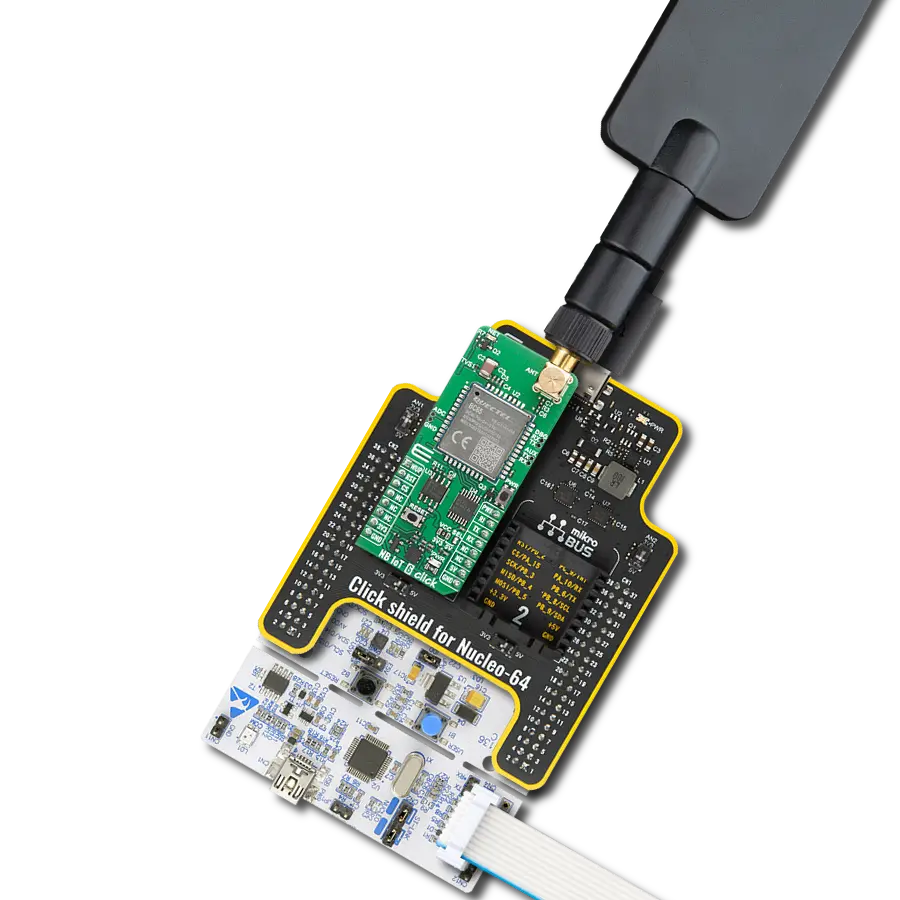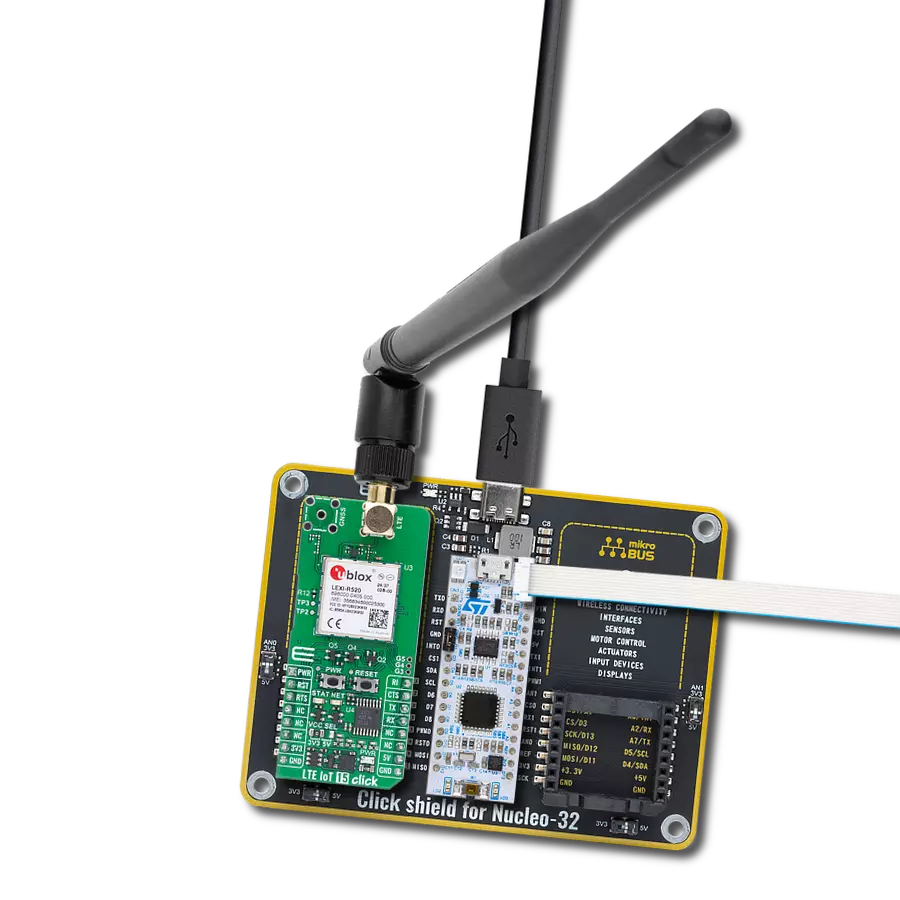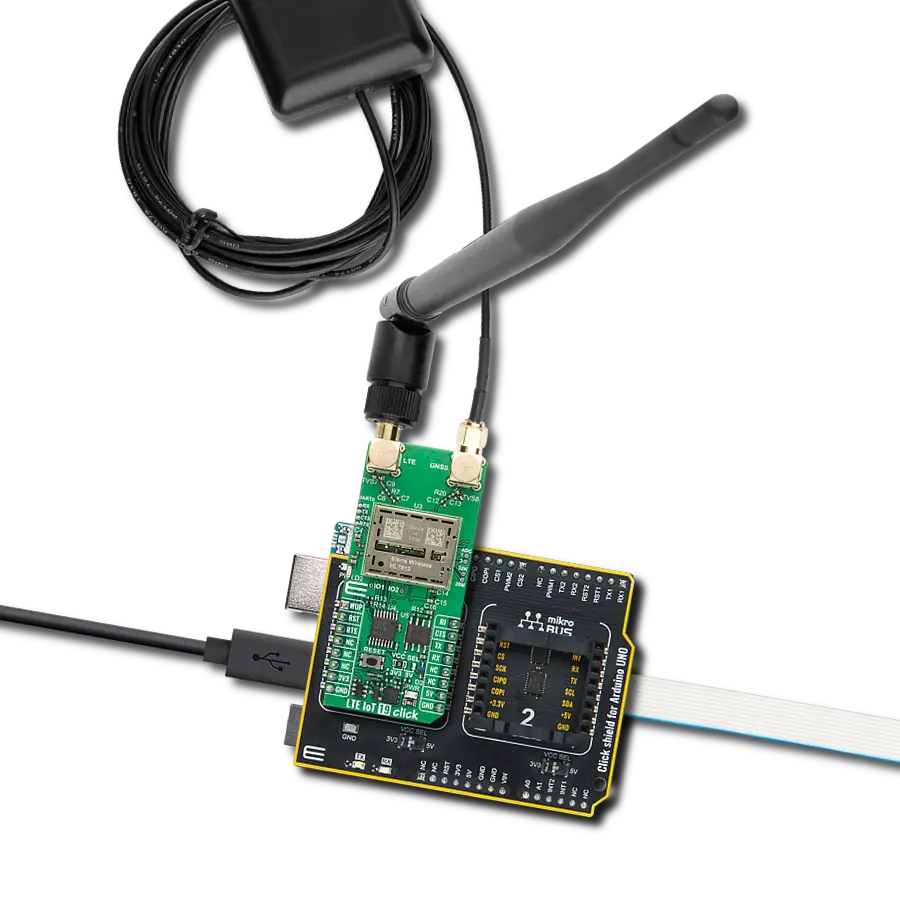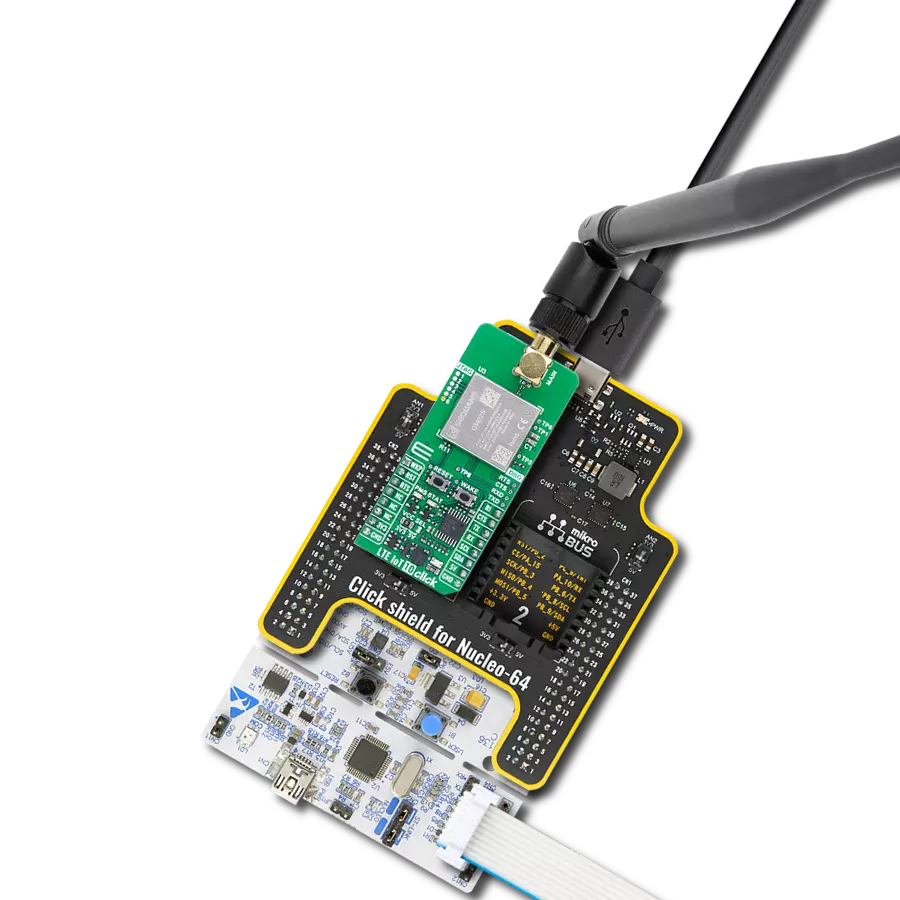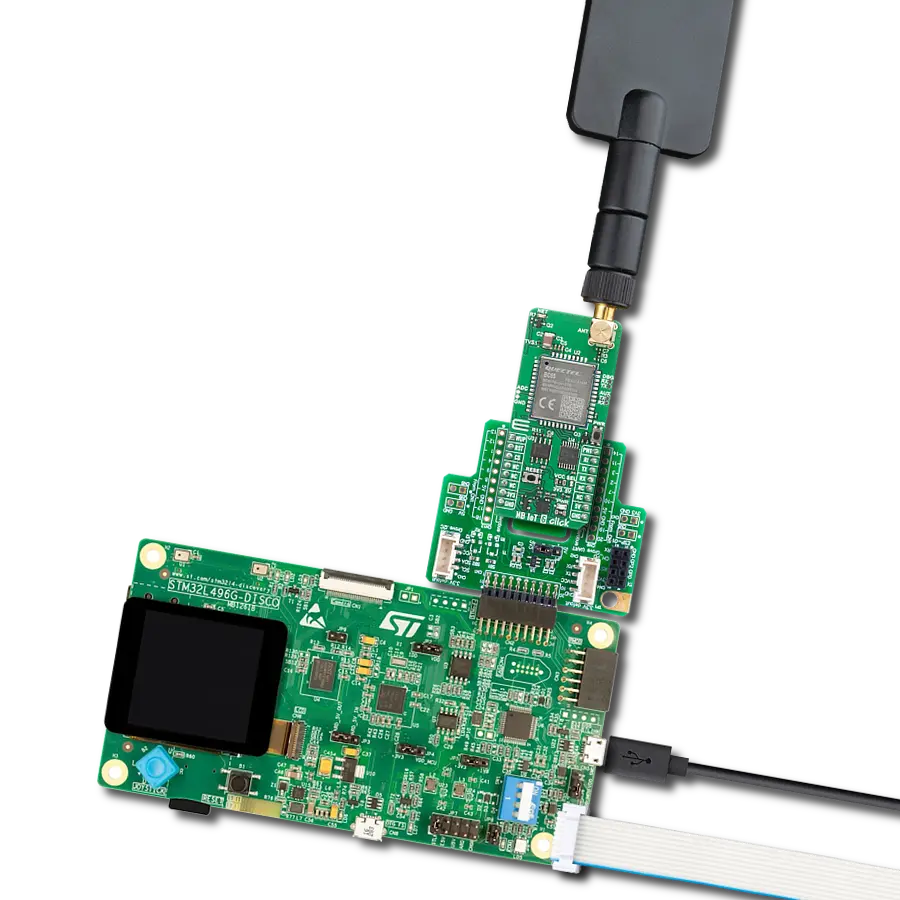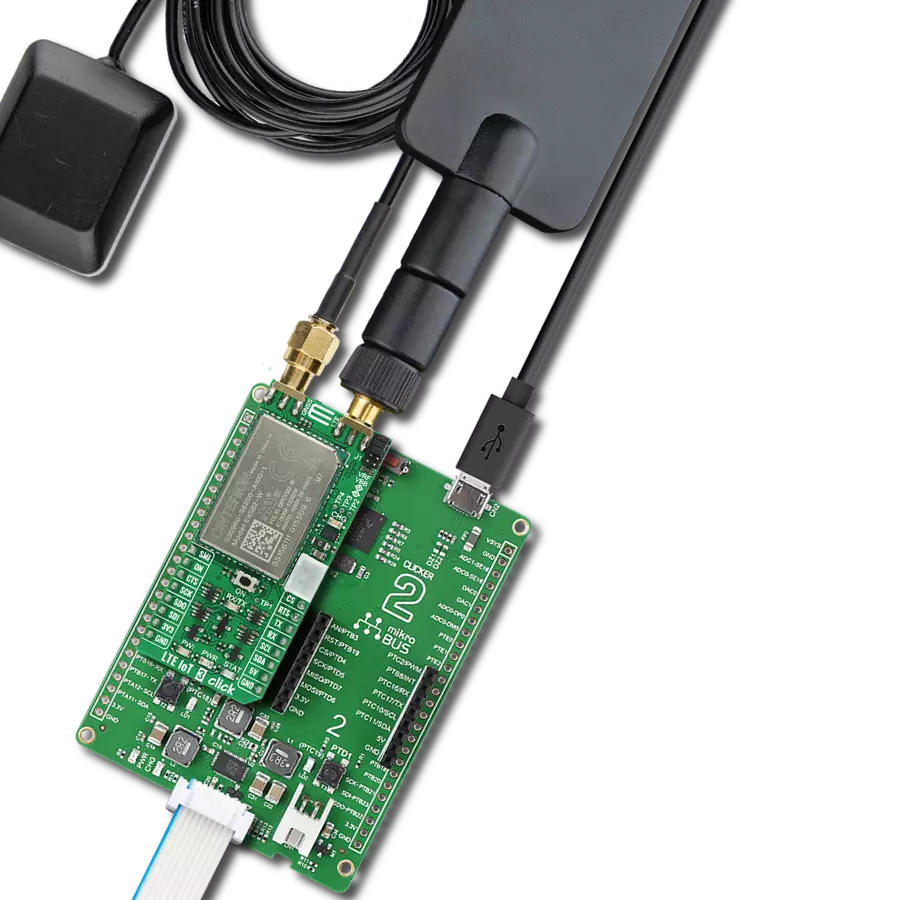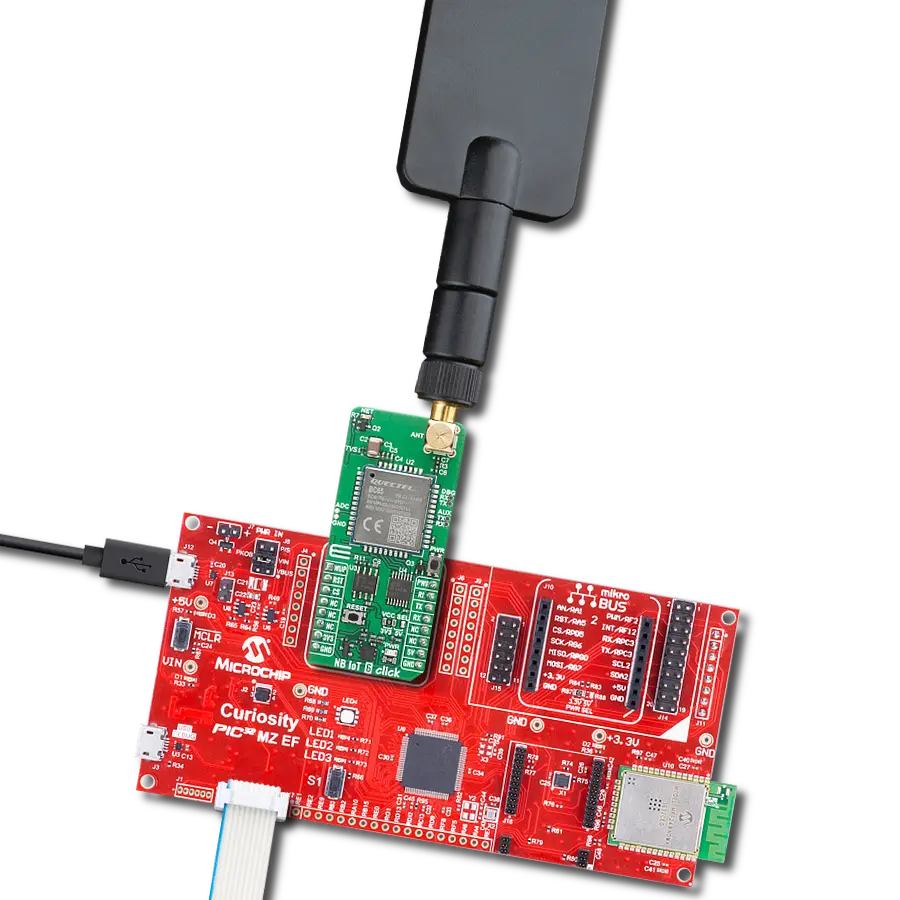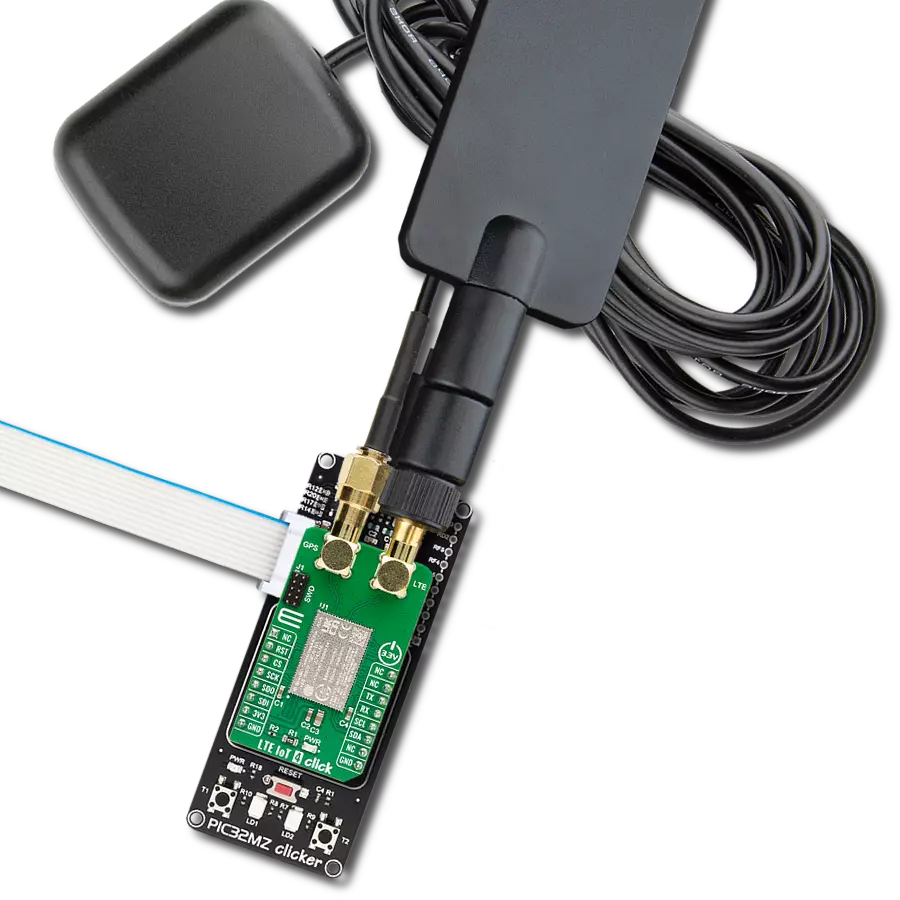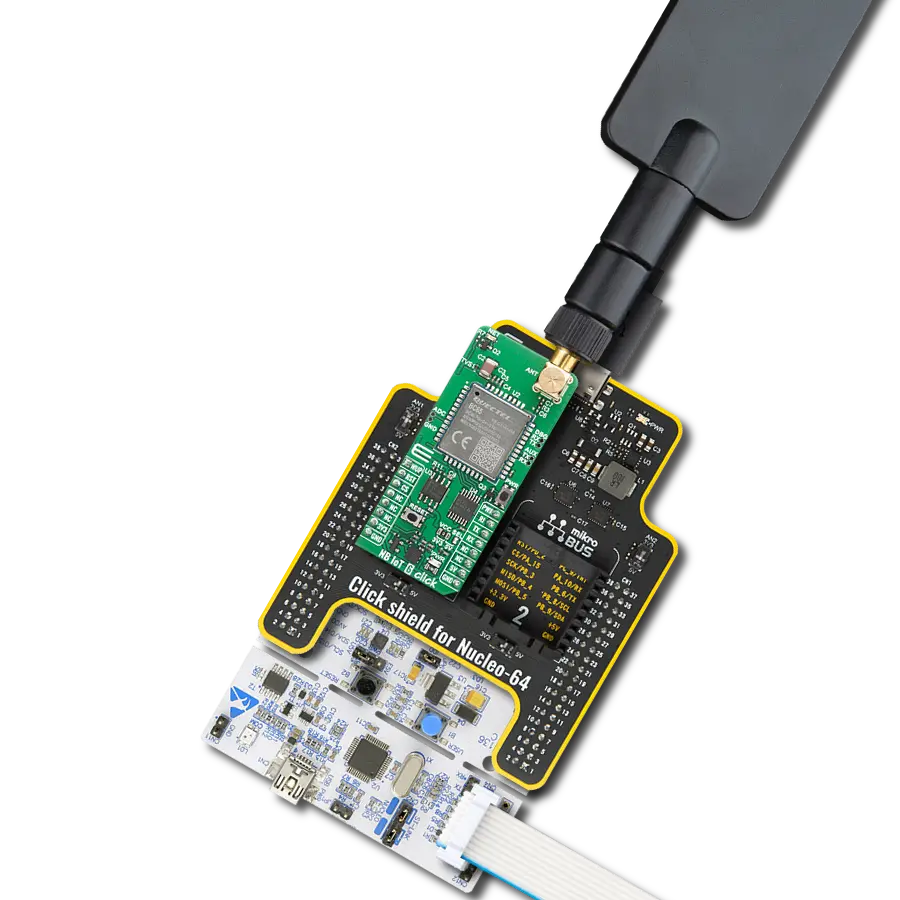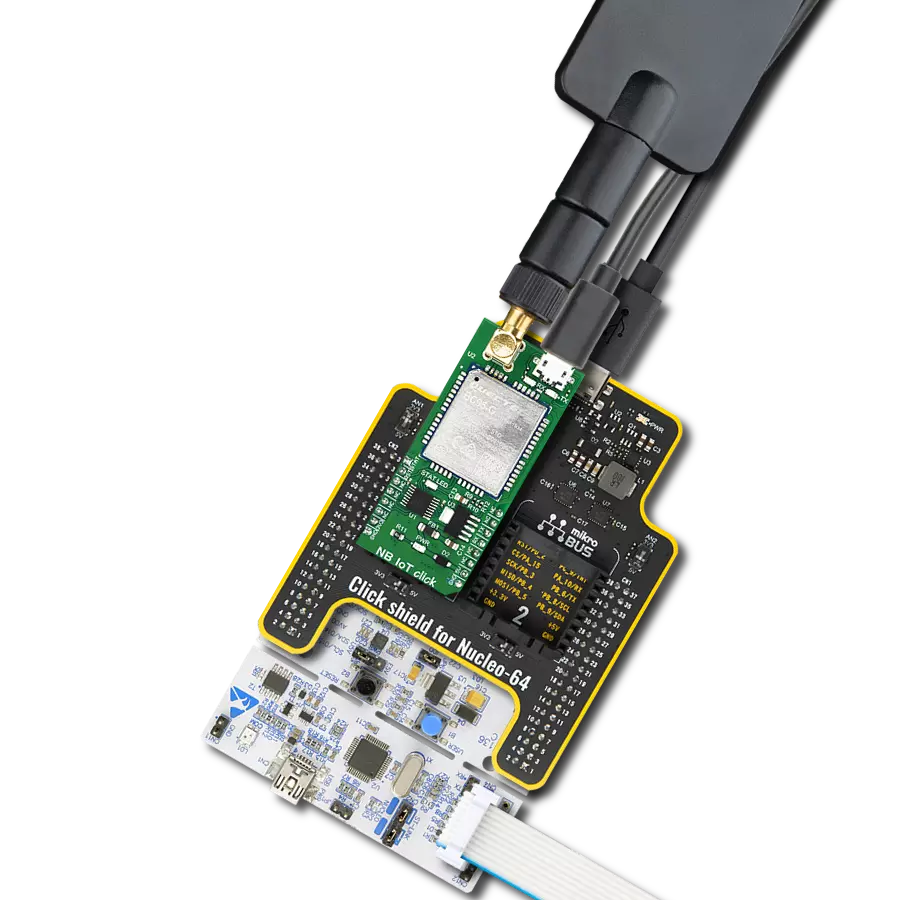发现我们先进的LTE物联网解决方案所带来的无限连接力量。通过我们的技术,设备间的通信方式得到了改变,重新定义了可能性,使得超越传统的物联网体验成为可能。
A
A
硬件概览
它是如何工作的?
LTE IoT 5 Click基于SARA-R510M8S,这是一款支持LTE Cat M1/Cat NB2频段的蜂窝模块,配备了来自Trasna的集成高性能标准精密M8 GNSS接收器。它采用了迷你的SARA LGA封装模块,可以直接替代其他Trasna蜂窝模块系列。SARA-R510系列模块提供基于软件的多频段配置,支持LTE Cat M1/NB2无线接入技术,可实现国际多区域覆盖,支持一套全面的3GPP Rel. 14功能,适用于数据传输速率高达1200 kbit/s的物联网应用。SARA-R510M8S的GNSS射频输入设计为50Ω特性阻抗,具有内部直流阻挡器,适用于主动和被动GNSS天线,因为内置的SAW滤波器跟随一个LNA位于集成的高性能Trasna M8并发定位引擎前面。该模块需要3.8V的电源供应。因此,Click board™集成了由德州仪器(Texas Instruments)标记为TPS7A7002的集成降压(降压DC-DC)转换器。该IC可输出高达3A的电流,保持良好的调节。其任务是提供稳定的3.8V电源,能够在输入出现高电流峰值时(通
常在设备启动时)减小电压下降。SARA-R510M8S使用UART接口与MCU通信,自动波特率检测用于来自外部应用主处理器的模块控制,可以通过Trasna提供的AT命令进行便捷配置。此Click board™还符合USB 2.0规范,配备了USB Type C连接器,最大数据速率为480 Mbit/s,仅用于诊断目的。该模块作为USB设备,可以连接到任何具有兼容驱动程序的USB主机。除了两个女性SMA连接器(用于LTE和主动GNSS天线),LTE IoT 5 Click还具有一个nano-SIM卡槽,可提供多个连接和接口选项。J1标头允许您访问SARA模块的可配置GPIO和EXT中断引脚,而从TP1到TP6标记的测试点可实现模块的轻松固件升级和测试。板载的低电平推按钮标记为PWR,路由到mikroBUS™插座上的AN引脚,代表点火(上电)按钮,成功操作将由STAT LED指示。如果设备已上电,则在此引脚上产生1.5s的低电平脉冲将关闭模块电源。也可以通过发出AT+CPWROFF命令或使用路由到mikroBUS™
插座上的RST引脚的复位功能将模块关闭电源,这将通过在此引脚上产生持续10s的低电平输入来导致突然关闭电源(强制关闭电源)。除了电源LED指示灯外,此Click board™还有两个额外的LED指示灯:黄色LED标记为STAT用于直观指示设备的操作状态,红色LED标记为TX用于指示网络状态。通过uFOTA客户端/服务器解决方案,客户可以通过空中固件更新为其解决方案未来化,该解决方案利用LwM2M,这是一种轻便紧凑的适用于物联网的协议。我们还提供了直接连接到TxD和RxD引脚的可访问测试点,用于固件升级目的。此Click board™可以通过VCC SEL跳线选择3.3V或5V逻辑电压电平运行。这样,既能使用3.3V也能使用5V逻辑电平的MCU可以正确使用通信线路。此外,此Click board™配备了一个包含易于使用的功能和示例代码的库,可用作进一步开发的参考。
功能概述
开发板
PIC18F57Q43 Curiosity Nano 评估套件是一款尖端的硬件平台,旨在评估 PIC18-Q43 系列内的微控制器。其设计的核心是包含了功能强大的 PIC18F57Q43 微控制器(MCU),提供先进的功能和稳健的性能。这个评估套件的关键特点包括一个黄 色用户 LED 和一个响应灵敏的机械用户开关,提供无
缝的交互和测试。为一个 32.768kHz 水晶振荡器足迹提供支持,确保精准的定时能力。套件内置的调试器拥有一个绿色电源和状态 LED,使编程和调试变得直观高效。此外,增强其实用性的还有虚拟串行端口 (CDC)和一个调试 GPIO 通道(DGI GPIO),提供广泛的连接选项。该套件通过 USB 供电,拥有由
MIC5353 LDO 调节器提供支持的可调目标电压功能,确保在 1.8V 至 5.1V 的输出电压范围内稳定运行,最大输出电流为 500mA,受环境温度和电压限制。
微控制器概述
MCU卡片 / MCU

建筑
PIC
MCU 内存 (KB)
128
硅供应商
Microchip
引脚数
48
RAM (字节)
8196
你完善了我!
配件
Curiosity Nano Base for Click boards 是一款多功能硬件扩展平台,专为简化 Curiosity Nano 套件与扩展板之间的集成而设计,特别针对符合 mikroBUS™ 标准的 Click 板和 Xplained Pro 扩展板。这款创新的基板(屏蔽板)提供了无缝的连接和扩展可能性,简化了实验和开发过程。主要特点包括从 Curiosity Nano 套件提供 USB 电源兼容性,以及为增强灵活性而提供的另一种外部电源输入选项。板载锂离子/锂聚合物充电器和管理电路确保电池供电应用的平稳运行,简化了使用和管理。此外,基板内置了一个固定的 3.3V 电源供应单元,专用于目标和 mikroBUS™ 电源轨,以及一个固定的 5.0V 升压转换器,专供 mikroBUS™ 插座的 5V 电源轨,为各种连接设备提供稳定的电力供应。
LTE扁平旋转天线是提升3G/4G LTE设备性能的多功能选择。其宽频范围为700-2700MHz,确保在全球主要蜂窝频段上实现最佳连接。这款扁平天线采用SMA公头连接器,方便直接连接到您的设备或SMA模块连接器。其突出特点之一是可调节角度,可设置为45⁰的增量(0⁰/45⁰/90⁰),使您可以微调天线的方向以实现最大的信号接收。该天线的阻抗为50Ω,VSWR比率为<2.0:1,确保可靠高效的连接。其5dB增益、垂直极化和全向辐射模式增强了信号强度,适用于各种应用场景。尺寸为196mm×38mm,既紧凑又有效,可提供改善连接的解决方案。最大输入功率为50W,可满足各种设备的需求。
使用的MCU引脚
mikroBUS™映射器
“仔细看看!”
Click board™ 原理图

一步一步来
项目组装
软件支持
库描述
该库包含 LTE IoT 5 Click 驱动程序的 API。
关键功能:
lteiot5_generic_read- LTE IoT 5数据读取函数lteiot5_send_cmd- 发送命令函数lteiot5_power_on- LTE IoT 5开机
开源
代码示例
完整的应用程序代码和一个现成的项目可以通过NECTO Studio包管理器直接安装到NECTO Studio。 应用程序代码也可以在MIKROE的GitHub账户中找到。
/*!
* @file main.c
* @brief LTE IoT 5 Click Example.
*
* # Description
* Application example shows device capability of connecting to the network and
* sending SMS or TCP/UDP messages, or retrieving data from GNSS using standard "AT" commands.
*
* The demo application is composed of two sections :
*
* ## Application Init
* Initializes the driver and logger.
*
* ## Application Task
* Application task is split in few stages:
* - LTEIOT5_POWER_UP:
* Powers up the device, performs a device factory reset and reads system information.
*
* - LTEIOT5_CONFIG_CONNECTION:
* Sets configuration to device to be able to connect to the network (used only for SMS or TCP/UDP demo examples).
*
* - LTEIOT5_CHECK_CONNECTION:
* Waits for the network registration indicated via CEREG command and then checks the signal quality report
* (used only for SMS or TCP/UDP demo examples).
*
* - LTEIOT5_CONFIG_EXAMPLE:
* Configures device for the selected example.
*
* - LTEIOT5_EXAMPLE:
* Depending on the selected demo example, it sends an SMS message (in PDU or TXT mode) or TCP/UDP message or
* waits for the GPS fix to retrieve location info from GNSS.
*
* By default, the TCP/UDP example is selected.
*
* ## Additional Function
* - static void lteiot5_clear_app_buf ( void )
* - static void lteiot5_log_app_buf ( void )
* - static err_t lteiot5_process ( lteiot5_t *ctx )
* - static err_t lteiot5_read_response ( lteiot5_t *ctx, uint8_t *rsp )
* - static err_t lteiot5_power_up ( lteiot5_t *ctx )
* - static err_t lteiot5_config_connection ( lteiot5_t *ctx )
* - static err_t lteiot5_check_connection ( lteiot5_t *ctx )
* - static err_t lteiot5_config_example ( lteiot5_t *ctx )
* - static err_t lteiot5_example ( lteiot5_t *ctx )
*
* @note
* In order for the examples to work (except GNSS example), user needs to set the APN and SMSC (SMS PDU mode only)
* of entered SIM card as well as the phone number (SMS mode only) to which he wants to send an SMS.
* Enter valid values for the following macros: SIM_APN, SIM_SMSC and PHONE_NUMBER.
* Example:
SIM_APN "internet"
SIM_SMSC "+381610401"
PHONE_NUMBER "+381659999999"
*
* @author Stefan Filipovic
*
*/
#include "board.h"
#include "log.h"
#include "lteiot5.h"
#include "generic_pointer.h"
#include "conversions.h"
// Example selection macros
#define EXAMPLE_TCP_UDP 0 // Example of sending messages to a TCP/UDP echo server
#define EXAMPLE_SMS 1 // Example of sending SMS to a phone number
#define EXAMPLE_GNSS 2 // Example of retrieving location info from GNSS
#define DEMO_EXAMPLE EXAMPLE_TCP_UDP // Example selection macro
// SIM APN config
#define SIM_APN "internet" // Set valid SIM APN
// SMS example parameters
#define SIM_SMSC "" // Set valid SMS Service Center Address - only in SMS PDU mode
#define PHONE_NUMBER "" // Set Phone number to message
#define SMS_MODE "1" // SMS mode: "0" - PDU, "1" - TXT
// TCP/UDP example parameters
#define REMOTE_IP "54.187.244.144"// TCP/UDP echo server IP address
#define REMOTE_PORT "51111" // TCP/UDP echo server port
// Message content
#define MESSAGE_CONTENT "LTE IoT 5 Click board - demo example."
// Application buffer size
#define APP_BUFFER_SIZE 256
#define PROCESS_BUFFER_SIZE 256
/**
* @brief Example states.
* @details Predefined enum values for application example state.
*/
typedef enum
{
LTEIOT5_POWER_UP = 1,
LTEIOT5_CONFIG_CONNECTION,
LTEIOT5_CHECK_CONNECTION,
LTEIOT5_CONFIG_EXAMPLE,
LTEIOT5_EXAMPLE
} lteiot5_app_state_t;
/**
* @brief Application example variables.
* @details Variables used in application example.
*/
static uint8_t app_buf[ APP_BUFFER_SIZE ] = { 0 };
static int32_t app_buf_len = 0;
static lteiot5_app_state_t app_state = LTEIOT5_POWER_UP;
static lteiot5_t lteiot5;
static log_t logger;
/**
* @brief LTE IoT 5 clearing application buffer.
* @details This function clears memory of application buffer and reset its length.
* @note None.
*/
static void lteiot5_clear_app_buf ( void );
/**
* @brief LTE IoT 5 log application buffer.
* @details This function logs data from application buffer to USB UART.
* @note None.
*/
static void lteiot5_log_app_buf ( void );
/**
* @brief LTE IoT 5 data reading function.
* @details This function reads data from device and concatenates data to application buffer.
* @param[in] ctx : Click context object.
* See #lteiot5_t object definition for detailed explanation.
* @return @li @c 0 - Read some data.
* @li @c -1 - Nothing is read.
* See #err_t definition for detailed explanation.
* @note None.
*/
static err_t lteiot5_process ( lteiot5_t *ctx );
/**
* @brief LTE IoT 5 read response function.
* @details This function waits for a response message, reads and displays it on the USB UART.
* @param[in] ctx : Click context object.
* See #lteiot5_t object definition for detailed explanation.
* @param[in] rsp Expected response.
* @return @li @c 0 - OK response.
* @li @c -2 - Timeout error.
* @li @c -3 - Command error.
* See #err_t definition for detailed explanation.
* @note None.
*/
static err_t lteiot5_read_response ( lteiot5_t *ctx, uint8_t *rsp );
/**
* @brief LTE IoT 5 power up function.
* @details This function powers up the device, performs a factory reset and reads system information.
* @param[in] ctx : Click context object.
* See #lteiot5_t object definition for detailed explanation.
* @return @li @c 0 - OK.
* @li @c != 0 - Read response error.
* See #err_t definition for detailed explanation.
* @note None.
*/
static err_t lteiot5_power_up ( lteiot5_t *ctx );
/**
* @brief LTE IoT 5 config connection function.
* @details This function configures and enables connection to the specified network.
* @param[in] ctx : Click context object.
* See #lteiot5_t object definition for detailed explanation.
* @return @li @c 0 - OK.
* @li @c != 0 - Read response error.
* See #err_t definition for detailed explanation.
* @note None.
*/
static err_t lteiot5_config_connection ( lteiot5_t *ctx );
/**
* @brief LTE IoT 5 check connection function.
* @details This function checks the connection to network.
* @param[in] ctx : Click context object.
* See #lteiot5_t object definition for detailed explanation.
* @return @li @c 0 - OK.
* @li @c != 0 - Read response error.
* See #err_t definition for detailed explanation.
* @note None.
*/
static err_t lteiot5_check_connection ( lteiot5_t *ctx );
/**
* @brief LTE IoT 5 config example function.
* @details This function configures device for the selected example.
* @param[in] ctx : Click context object.
* See #lteiot5_t object definition for detailed explanation.
* @return @li @c 0 - OK.
* @li @c != 0 - Read response error.
* See #err_t definition for detailed explanation.
* @note None.
*/
static err_t lteiot5_config_example ( lteiot5_t *ctx );
/**
* @brief LTE IoT 5 example function.
* @details This function executes SMS or TCP/UDP depending on the DEMO_EXAMPLE macro.
* @param[in] ctx : Click context object.
* See #lteiot5_t object definition for detailed explanation.
* @return @li @c 0 - OK.
* @li @c != 0 - Read response error.
* See #err_t definition for detailed explanation.
* @note None.
*/
static err_t lteiot5_example ( lteiot5_t *ctx );
void application_init ( void )
{
log_cfg_t log_cfg; /**< Logger config object. */
lteiot5_cfg_t lteiot5_cfg; /**< Click config object. */
/**
* Logger initialization.
* Default baud rate: 115200
* Default log level: LOG_LEVEL_DEBUG
* @note If USB_UART_RX and USB_UART_TX
* are defined as HAL_PIN_NC, you will
* need to define them manually for log to work.
* See @b LOG_MAP_USB_UART macro definition for detailed explanation.
*/
LOG_MAP_USB_UART( log_cfg );
log_init( &logger, &log_cfg );
log_info( &logger, " Application Init " );
// Click initialization.
lteiot5_cfg_setup( <eiot5_cfg );
LTEIOT5_MAP_MIKROBUS( lteiot5_cfg, MIKROBUS_1 );
if ( UART_ERROR == lteiot5_init( <eiot5, <eiot5_cfg ) )
{
log_error( &logger, " Communication init." );
for ( ; ; );
}
log_info( &logger, " Application Task " );
app_state = LTEIOT5_POWER_UP;
log_printf( &logger, ">>> APP STATE - POWER UP <<<\r\n\n" );
}
void application_task ( void )
{
switch ( app_state )
{
case LTEIOT5_POWER_UP:
{
if ( LTEIOT5_OK == lteiot5_power_up( <eiot5 ) )
{
app_state = LTEIOT5_CONFIG_CONNECTION;
log_printf( &logger, ">>> APP STATE - CONFIG CONNECTION <<<\r\n\n" );
}
break;
}
case LTEIOT5_CONFIG_CONNECTION:
{
if ( LTEIOT5_OK == lteiot5_config_connection( <eiot5 ) )
{
app_state = LTEIOT5_CHECK_CONNECTION;
log_printf( &logger, ">>> APP STATE - CHECK CONNECTION <<<\r\n\n" );
}
break;
}
case LTEIOT5_CHECK_CONNECTION:
{
if ( LTEIOT5_OK == lteiot5_check_connection( <eiot5 ) )
{
app_state = LTEIOT5_CONFIG_EXAMPLE;
log_printf( &logger, ">>> APP STATE - CONFIG EXAMPLE <<<\r\n\n" );
}
break;
}
case LTEIOT5_CONFIG_EXAMPLE:
{
if ( LTEIOT5_OK == lteiot5_config_example( <eiot5 ) )
{
app_state = LTEIOT5_EXAMPLE;
log_printf( &logger, ">>> APP STATE - EXAMPLE <<<\r\n\n" );
}
break;
}
case LTEIOT5_EXAMPLE:
{
lteiot5_example( <eiot5 );
break;
}
default:
{
log_error( &logger, " APP STATE." );
break;
}
}
}
int main ( void )
{
/* Do not remove this line or clock might not be set correctly. */
#ifdef PREINIT_SUPPORTED
preinit();
#endif
application_init( );
for ( ; ; )
{
application_task( );
}
return 0;
}
static void lteiot5_clear_app_buf ( void )
{
memset( app_buf, 0, app_buf_len );
app_buf_len = 0;
}
static void lteiot5_log_app_buf ( void )
{
for ( int32_t buf_cnt = 0; buf_cnt < app_buf_len; buf_cnt++ )
{
log_printf( &logger, "%c", app_buf[ buf_cnt ] );
}
}
static err_t lteiot5_process ( lteiot5_t *ctx )
{
uint8_t rx_buf[ PROCESS_BUFFER_SIZE ] = { 0 };
int32_t overflow_bytes = 0;
int32_t rx_cnt = 0;
int32_t rx_size = lteiot5_generic_read( ctx, rx_buf, PROCESS_BUFFER_SIZE );
if ( ( rx_size > 0 ) && ( rx_size <= APP_BUFFER_SIZE ) )
{
if ( ( app_buf_len + rx_size ) > APP_BUFFER_SIZE )
{
overflow_bytes = ( app_buf_len + rx_size ) - APP_BUFFER_SIZE;
app_buf_len = APP_BUFFER_SIZE - rx_size;
memmove ( app_buf, &app_buf[ overflow_bytes ], app_buf_len );
memset ( &app_buf[ app_buf_len ], 0, overflow_bytes );
}
for ( rx_cnt = 0; rx_cnt < rx_size; rx_cnt++ )
{
if ( rx_buf[ rx_cnt ] )
{
app_buf[ app_buf_len++ ] = rx_buf[ rx_cnt ];
}
}
return LTEIOT5_OK;
}
return LTEIOT5_ERROR;
}
static err_t lteiot5_read_response ( lteiot5_t *ctx, uint8_t *rsp )
{
#define READ_RESPONSE_TIMEOUT_MS 120000
uint32_t timeout_cnt = 0;
lteiot5_clear_app_buf ( );
lteiot5_process( ctx );
while ( ( 0 == strstr( app_buf, rsp ) ) &&
( 0 == strstr( app_buf, LTEIOT5_RSP_ERROR ) ) )
{
lteiot5_process( ctx );
if ( timeout_cnt++ > READ_RESPONSE_TIMEOUT_MS )
{
lteiot5_log_app_buf( );
lteiot5_clear_app_buf( );
log_error( &logger, " Timeout!" );
return LTEIOT5_ERROR_TIMEOUT;
}
Delay_ms( 1 );
}
Delay_ms ( 200 );
lteiot5_process( ctx );
lteiot5_log_app_buf( );
if ( strstr( app_buf, rsp ) )
{
log_printf( &logger, "--------------------------------\r\n" );
return LTEIOT5_OK;
}
return LTEIOT5_ERROR_CMD;
}
static err_t lteiot5_power_up ( lteiot5_t *ctx )
{
err_t error_flag = LTEIOT5_OK;
uint8_t power_state = LTEIOT5_POWER_STATE_OFF;
for ( ; ; )
{
lteiot5_process( ctx );
lteiot5_log_app_buf ( );
lteiot5_clear_app_buf ( );
// Wake up UART interface
lteiot5_cmd_run( ctx, LTEIOT5_CMD_AT );
log_printf( &logger, ">>> Check communication.\r\n" );
lteiot5_cmd_run( ctx, LTEIOT5_CMD_AT );
if ( ( ( LTEIOT5_OK == lteiot5_process( ctx ) ) && strstr( app_buf, LTEIOT5_RSP_OK ) ) )
{
power_state = LTEIOT5_POWER_STATE_ON;
break;
}
else if ( LTEIOT5_POWER_STATE_OFF == power_state )
{
power_state = LTEIOT5_POWER_STATE_ON;
log_printf( &logger, ">>> Power up device.\r\n" );
lteiot5_set_power_state ( ctx, LTEIOT5_POWER_STATE_ON );
}
else if ( LTEIOT5_POWER_STATE_ON == power_state )
{
power_state = LTEIOT5_POWER_STATE_OFF;
log_printf( &logger, ">>> Power down device.\r\n" );
lteiot5_set_power_state ( ctx, LTEIOT5_POWER_STATE_OFF );
}
}
lteiot5_cmd_run( ctx, LTEIOT5_CMD_AT );
error_flag |= lteiot5_read_response( ctx, LTEIOT5_RSP_OK );
log_printf( &logger, ">>> Factory reset.\r\n" );
lteiot5_cmd_run( ctx, LTEIOT5_CMD_FACTORY_RESET );
error_flag |= lteiot5_read_response( ctx, LTEIOT5_RSP_OK );
log_printf( &logger, ">>> Get device software version ID.\r\n" );
lteiot5_cmd_run( ctx, LTEIOT5_CMD_GET_SW_VERSION );
error_flag |= lteiot5_read_response( ctx, LTEIOT5_RSP_OK );
log_printf( &logger, ">>> Get device serial number.\r\n" );
lteiot5_cmd_run( ctx, LTEIOT5_CMD_GET_SERIAL_NUM );
error_flag |= lteiot5_read_response( ctx, LTEIOT5_RSP_OK );
return error_flag;
}
static err_t lteiot5_config_connection ( lteiot5_t *ctx )
{
err_t error_flag = LTEIOT5_OK;
#if ( ( DEMO_EXAMPLE == EXAMPLE_TCP_UDP ) || ( DEMO_EXAMPLE == EXAMPLE_SMS ) )
log_printf( &logger, ">>> Deregister from network.\r\n" );
#define DEREGISTER_FROM_NETWORK "2"
lteiot5_cmd_set( ctx, LTEIOT5_CMD_OPERATOR_SELECTION, DEREGISTER_FROM_NETWORK );
error_flag |= lteiot5_read_response( ctx, LTEIOT5_RSP_OK );
log_printf( &logger, ">>> Set SIM APN.\r\n" );
lteiot5_set_sim_apn( <eiot5, SIM_APN );
error_flag |= lteiot5_read_response( ctx, LTEIOT5_RSP_OK );
log_printf( &logger, ">>> Enable full functionality.\r\n" );
#define FULL_FUNCTIONALITY "1"
lteiot5_cmd_set( ctx, LTEIOT5_CMD_SET_MODULE_FUNCTIONALITY, FULL_FUNCTIONALITY );
error_flag |= lteiot5_read_response( ctx, LTEIOT5_RSP_OK );
log_printf( &logger, ">>> Enable network registration.\r\n" );
#define ENABLE_REG "2"
lteiot5_cmd_set( ctx, LTEIOT5_CMD_EPS_NETWORK_REGISTRATION, ENABLE_REG );
error_flag |= lteiot5_read_response( ctx, LTEIOT5_RSP_OK );
log_printf( &logger, ">>> Set automatic registration.\r\n" );
#define AUTOMATIC_REGISTRATION "0"
lteiot5_cmd_set( ctx, LTEIOT5_CMD_OPERATOR_SELECTION, AUTOMATIC_REGISTRATION );
error_flag |= lteiot5_read_response( ctx, LTEIOT5_RSP_OK );
#endif
return error_flag;
}
static err_t lteiot5_check_connection ( lteiot5_t *ctx )
{
err_t error_flag = LTEIOT5_OK;
#if ( ( DEMO_EXAMPLE == EXAMPLE_TCP_UDP ) || ( DEMO_EXAMPLE == EXAMPLE_SMS ) )
log_printf( &logger, ">>> Check network registration.\r\n" );
#define CONNECTED "+CEREG: 2,1"
lteiot5_cmd_get ( <eiot5, LTEIOT5_CMD_EPS_NETWORK_REGISTRATION );
error_flag |= lteiot5_read_response( ctx, LTEIOT5_RSP_OK );
if ( strstr( app_buf, CONNECTED ) )
{
Delay_ms ( 1000 );
log_printf( &logger, ">>> Check signal quality.\r\n" );
lteiot5_cmd_run ( <eiot5, LTEIOT5_CMD_SIGNAL_QUALITY_REPORT );
error_flag |= lteiot5_read_response( ctx, LTEIOT5_RSP_OK );
}
else
{
error_flag = LTEIOT5_ERROR;
Delay_ms ( 1000 );
Delay_ms ( 1000 );
}
#endif
return error_flag;
}
static err_t lteiot5_config_example ( lteiot5_t *ctx )
{
err_t error_flag = LTEIOT5_OK;
#if ( DEMO_EXAMPLE == EXAMPLE_TCP_UDP )
log_printf( &logger, ">>> Activate PDP context.\r\n" );
#define ACTIVATE_PDP_CONTEXT "1,1"
lteiot5_cmd_set( <eiot5, LTEIOT5_CMD_ACTIVATE_PDP_CONTEXT, ACTIVATE_PDP_CONTEXT );
error_flag |= lteiot5_read_response( ctx, LTEIOT5_RSP_OK );
log_printf( &logger, ">>> Set PDP type to IPv4.\r\n" );
#define SET_PDP_TYPE_IPV4 "0,0,0"
lteiot5_cmd_set( <eiot5, LTEIOT5_CMD_PSD_CONFIG, SET_PDP_TYPE_IPV4 );
error_flag |= lteiot5_read_response( ctx, LTEIOT5_RSP_OK );
log_printf( &logger, ">>> Map PSD profile to CID.\r\n" );
#define MAP_PSD_PROFILE "0,100,1"
lteiot5_cmd_set( <eiot5, LTEIOT5_CMD_PSD_CONFIG, MAP_PSD_PROFILE );
error_flag |= lteiot5_read_response( ctx, LTEIOT5_RSP_OK );
log_printf( &logger, ">>> Activate PSD profile.\r\n" );
#define ACTIVATE_PSD_PROFILE "0,3"
lteiot5_cmd_set( <eiot5, LTEIOT5_CMD_PSD_ACTION, ACTIVATE_PSD_PROFILE );
error_flag |= lteiot5_read_response( ctx, LTEIOT5_RSP_OK );
log_printf( &logger, ">>> Show PDP address.\r\n" );
#define PDP_CID "1"
lteiot5_cmd_set( <eiot5, LTEIOT5_CMD_SHOW_PDP_ADDRESS, PDP_CID );
error_flag |= lteiot5_read_response( ctx, LTEIOT5_RSP_OK );
#elif ( DEMO_EXAMPLE == EXAMPLE_SMS )
log_printf( &logger, ">>> Select SMS format.\r\n" );
lteiot5_cmd_set( <eiot5, LTEIOT5_CMD_SELECT_SMS_FORMAT, SMS_MODE );
error_flag |= lteiot5_read_response( ctx, LTEIOT5_RSP_OK );
#elif ( DEMO_EXAMPLE == EXAMPLE_GNSS )
log_printf( &logger, ">>> Check GNSS enable.\r\n" );
lteiot5_cmd_get( <eiot5, LTEIOT5_CMD_GNSS_POWER_MANAGEMENT );
error_flag |= lteiot5_read_response( ctx, LTEIOT5_RSP_OK );
#define GNSS_POWERED_OFF "+UGPS: 0"
if ( strstr( app_buf, GNSS_POWERED_OFF ) )
{
log_printf( &logger, ">>> Enable GNSS.\r\n" );
#define ENABLE_GNSS "1,0,1"
lteiot5_cmd_set( <eiot5, LTEIOT5_CMD_GNSS_POWER_MANAGEMENT, ENABLE_GNSS );
error_flag |= lteiot5_read_response( ctx, LTEIOT5_RSP_OK );
Delay_ms ( 1000 );
}
log_printf( &logger, ">>> Enable NMEA $GGA messages.\r\n" );
#define ENABLE_NMEA_GGA "1"
lteiot5_cmd_set( <eiot5, LTEIOT5_CMD_GET_GNSS_FIX_DATA, ENABLE_NMEA_GGA );
error_flag |= lteiot5_read_response( ctx, LTEIOT5_RSP_OK );
#endif
return error_flag;
}
static err_t lteiot5_example ( lteiot5_t *ctx )
{
err_t error_flag = LTEIOT5_OK;
#if ( DEMO_EXAMPLE == EXAMPLE_TCP_UDP )
uint8_t cmd_buf[ 100 ] = { 0 };
uint8_t * __generic_ptr socket_num_buf = 0;
uint8_t tcp_socket_num[ 2 ] = { 0 };
uint8_t udp_socket_num[ 2 ] = { 0 };
log_printf( &logger, ">>> Create TCP socket.\r\n" );
#define TCP_PROTOCOL "6"
lteiot5_cmd_set ( <eiot5, LTEIOT5_CMD_CREATE_SOCKET, TCP_PROTOCOL );
error_flag |= lteiot5_read_response( ctx, LTEIOT5_RSP_OK );
socket_num_buf = strstr( app_buf, LTEIOT5_URC_CREATE_SOCKET ) + strlen ( LTEIOT5_URC_CREATE_SOCKET );
if ( NULL != socket_num_buf )
{
tcp_socket_num[ 0 ] = *socket_num_buf;
}
log_printf( &logger, ">>> Create UDP socket.\r\n" );
#define UDP_PROTOCOL "17"
lteiot5_cmd_set ( <eiot5, LTEIOT5_CMD_CREATE_SOCKET, UDP_PROTOCOL );
error_flag |= lteiot5_read_response( ctx, LTEIOT5_RSP_OK );
socket_num_buf = strstr( app_buf, LTEIOT5_URC_CREATE_SOCKET ) + strlen ( LTEIOT5_URC_CREATE_SOCKET );
if ( NULL != socket_num_buf )
{
udp_socket_num[ 0 ] = *socket_num_buf;
}
log_printf( &logger, ">>> Open TCP connection.\r\n" );
strcpy( cmd_buf, tcp_socket_num );
strcat( cmd_buf, ",\"" );
strcat( cmd_buf, REMOTE_IP );
strcat( cmd_buf, "\"," );
strcat( cmd_buf, REMOTE_PORT );
lteiot5_cmd_set ( <eiot5, LTEIOT5_CMD_CONNECT_SOCKET, cmd_buf );
error_flag |= lteiot5_read_response( ctx, LTEIOT5_RSP_OK );
log_printf( &logger, ">>> Open UDP connection.\r\n" );
strcpy( cmd_buf, udp_socket_num );
strcat( cmd_buf, ",\"" );
strcat( cmd_buf, REMOTE_IP );
strcat( cmd_buf, "\"," );
strcat( cmd_buf, REMOTE_PORT );
lteiot5_cmd_set ( <eiot5, LTEIOT5_CMD_CONNECT_SOCKET, cmd_buf );
error_flag |= lteiot5_read_response( ctx, LTEIOT5_RSP_OK );
// Get message length
uint8_t message_len_buf[ 10 ] = { 0 };
uint16_t message_len = strlen( MESSAGE_CONTENT );
uint16_to_str( message_len, message_len_buf );
l_trim( message_len_buf );
r_trim( message_len_buf );
log_printf( &logger, ">>> Write message to TCP connection.\r\n" );
strcpy( cmd_buf, tcp_socket_num );
strcat( cmd_buf, "," );
strcat( cmd_buf, message_len_buf );
strcat( cmd_buf, ",\"" );
strcat( cmd_buf, MESSAGE_CONTENT );
strcat( cmd_buf, "\"" );
lteiot5_cmd_set ( <eiot5, LTEIOT5_CMD_WRITE_SOCKET_DATA, cmd_buf );
error_flag |= lteiot5_read_response( ctx, LTEIOT5_URC_RECEIVED_DATA );
log_printf( &logger, ">>> Read response from TCP connection.\r\n" );
strcpy( cmd_buf, tcp_socket_num );
strcat( cmd_buf, "," );
strcat( cmd_buf, message_len_buf );
lteiot5_cmd_set( <eiot5, LTEIOT5_CMD_READ_SOCKET_DATA, cmd_buf );
error_flag |= lteiot5_read_response( ctx, LTEIOT5_RSP_OK );
log_printf( &logger, ">>> Write message to UDP connection.\r\n" );
strcpy( cmd_buf, udp_socket_num );
strcat( cmd_buf, "," );
strcat( cmd_buf, message_len_buf );
strcat( cmd_buf, ",\"" );
strcat( cmd_buf, MESSAGE_CONTENT );
strcat( cmd_buf, "\"" );
lteiot5_cmd_set ( <eiot5, LTEIOT5_CMD_WRITE_SOCKET_DATA, cmd_buf );
error_flag |= lteiot5_read_response( ctx, LTEIOT5_URC_RECEIVED_DATA );
log_printf( &logger, ">>> Read response from UDP connection.\r\n" );
strcpy( cmd_buf, udp_socket_num );
strcat( cmd_buf, "," );
strcat( cmd_buf, message_len_buf );
lteiot5_cmd_set( <eiot5, LTEIOT5_CMD_READ_SOCKET_DATA, cmd_buf );
error_flag |= lteiot5_read_response( ctx, LTEIOT5_RSP_OK );
log_printf( &logger, ">>> Close TCP connection.\r\n" );
lteiot5_cmd_set ( <eiot5, LTEIOT5_CMD_CLOSE_SOCKET, tcp_socket_num );
error_flag |= lteiot5_read_response( ctx, LTEIOT5_RSP_OK );
log_printf( &logger, ">>> Close UDP connection.\r\n" );
lteiot5_cmd_set ( <eiot5, LTEIOT5_CMD_CLOSE_SOCKET, udp_socket_num );
error_flag |= lteiot5_read_response( ctx, LTEIOT5_RSP_OK );
Delay_ms ( 1000 );
Delay_ms ( 1000 );
Delay_ms ( 1000 );
Delay_ms ( 1000 );
Delay_ms ( 1000 );
#elif ( DEMO_EXAMPLE == EXAMPLE_SMS )
#define CMGF_PDU "+CMGF: 0"
#define CMGF_TXT "+CMGF: 1"
log_printf( &logger, ">>> Check SMS format.\r\n" );
lteiot5_cmd_get( <eiot5, LTEIOT5_CMD_SELECT_SMS_FORMAT );
error_flag |= lteiot5_read_response( ctx, LTEIOT5_RSP_OK );
if ( strstr( app_buf, CMGF_PDU ) )
{
log_printf( &logger, ">>> Send SMS in PDU mode.\r\n" );
lteiot5_send_sms_pdu( <eiot5, SIM_SMSC, PHONE_NUMBER, MESSAGE_CONTENT );
error_flag |= lteiot5_read_response( ctx, LTEIOT5_RSP_OK );
}
else if ( strstr( app_buf, CMGF_TXT ) )
{
log_printf( &logger, ">>> Send SMS in TXT mode.\r\n" );
lteiot5_send_sms_text ( <eiot5, PHONE_NUMBER, MESSAGE_CONTENT );
error_flag |= lteiot5_read_response( ctx, LTEIOT5_RSP_OK );
}
// 30 seconds delay
for ( uint8_t delay_cnt = 0; delay_cnt < 30; delay_cnt++ )
{
Delay_ms ( 1000 );
}
#elif ( DEMO_EXAMPLE == EXAMPLE_GNSS )
log_printf( &logger, ">>> Get GNSS fix data.\r\n" );
lteiot5_cmd_get( <eiot5, LTEIOT5_CMD_GET_GNSS_FIX_DATA );
error_flag |= lteiot5_read_response( ctx, LTEIOT5_RSP_OK );
if ( app_buf_len > ( sizeof ( LTEIOT5_RSP_GGA ) + LTEIOT5_GGA_ELEMENT_SIZE ) )
{
uint8_t element_buf[ 100 ] = { 0 };
if ( LTEIOT5_OK == lteiot5_parse_gga( app_buf, LTEIOT5_GGA_LATITUDE, element_buf ) )
{
if ( strlen( element_buf ) > 0 )
{
log_printf( &logger, "Latitude: %.2s degrees, %s minutes\r\n", element_buf, &element_buf[ 2 ] );
lteiot5_parse_gga( app_buf, LTEIOT5_GGA_LONGITUDE, element_buf );
log_printf( &logger, "Longitude: %.3s degrees, %s minutes\r\n", element_buf, &element_buf[ 3 ] );
memset( element_buf, 0, sizeof( element_buf ) );
lteiot5_parse_gga( app_buf, LTEIOT5_GGA_ALTITUDE, element_buf );
log_printf( &logger, "Altitude: %s m\r\n", element_buf );
}
else
{
log_printf( &logger, "Waiting for the position fix...\r\n" );
}
Delay_ms ( 5 );
log_printf( &logger, "--------------------------------\r\n" );
lteiot5_clear_app_buf( );
}
}
Delay_ms ( 1000 );
Delay_ms ( 1000 );
Delay_ms ( 1000 );
#else
#error "No demo example selected"
#endif
return error_flag;
}
// ------------------------------------------------------------------------ END
额外支持
资源
类别:LTE 物联网
























